
This year’s Halloween fest is heavily biased towards Hammer Horror, generally chronologically by release. So far: Curse of Frankenstein; Revenge of Frankenstein; Horror of Dracula and now… 

Most of these films were unobtainable here until the 2000s-Only ones I managed to see growing up were Evil of Frankenstein (arguably worst in Hammer’s series), and the 3rd and 4th Draculas (Prince of Darkness & Dracula has Risen From the Grave) plus occasionally Dracula 1972.
When I finally saw Horror of Dracula it quickly became my favorite of the novel adaptations, although they all have their moments-plan to watch a bunch more during this season, including Langella’s 78 version & the BBC one with Louis Jordan (1st time)
It’s difficult for modern horror fans to comprehend how revolutionary Curse of Frankenstein and (Horror of)Dracula by Hammer were-the Universal series had only vanished a decade prior-Hammer offered 1st color adaptations;1st blood;1st fangs!;1st cleavage & soon nudity. Big jumps.
But The Abominable Snowman is B&W and feels like the early Hammer sci-fi films, no doubt since it’s written by Quatermass creator Nigel Keale. Skipping them and X the Unknown in this Hammer marathon as horror-adjacent. Peter Cushing looks much less gaunt than he would soon become 



Dude on the right ain’t a fan of this Yeti seeking plan. #hammerhorror
The Abominable Snowman fits well with the other intelligent sci-fi films Hammer made in the 50s (Quatermass, X The Unknown). The Jon Pertwee era of Doctor Who is similar & my fav for that reason. Props for surprisingly early/easy slaying of the “monster”& then exploring deeper. 





Next up, the last of the great 1950s Hammer Horror relaunches, The Mummy, followed by Brides of Dracula, courtesy of these collected editions: 





While Hammer’s Dracula and especially Frankenstein movies strayed wildly from the precedents (and initially copyrights) set by the Universal series, Hammer’s Mummy closely follows the plot of the Universal sequels to Karloff’s Mummy (which was an anomaly compared to later films)
Perhaps because of that closer emulation, the superiority of Hammer’s iteration is stark: the color and cinematography are wonderful and there’s genuine horror and nastiness in how victims are dispatches. Christopher Lee’s Mummy has a real menace that Chaney’s bandaged oaf lacked
Working class stiffs being drunk, unethical and incompetent is a common trope in these early Hammer Horror flicks: the louts who are tasked with digging up the Baron’s body in Revenge of Frankenstein and these boozers who inadvertently drop the Mummy into a mire. 





The savagery of the monster attacks in these early Hammer films must have been truly shocking in the 1950s, and far beyond what Hollywood itself natively produced at the time. Curse of Frankenstein and the Mummy are so cruel in choosing victims and violent in their attacks.
Great example of the foregoing. Cushing is an agile, thinking man of action in these early Hammer movies (more Michael Biehn than Edward Van Sloan). Even as the Baron, but particularly in the Mummy and as Van Helsing in Horror of Dracula and Brides of Dracula.
A few final shots of Hammer’s 1959 Mummy, highlighting how unusually colourful the film is for the time. The older blu-ray in the Horror Classics set (posted above) has great image quality. Lee may have hated the Mummy makeup burden, but he transformed into a fearsome iteration. 







Brides of Dracula is next;like the immediate sequel to Universal’s 1931 Dracula, it eschews the Count altogether, and that symmetry appeals to me as an homage although that doesn’t seem to have been deliberate. Its opening suggests its title might be more meaningful than it is. 



Christopher Lee is the only Dracula who could truly frighten, but he’s also such a great orator,yet after the tense introductory verbal exchanges he has with Harker in Horror of Dracula, he devolves into a mute, animalistic menace the remainder of that film + his next appearance.
1958’s Dracula really misses the civilized interactions Stoker’s Dracula had with his victims. Van Helsing exposing Dracula with a mirror is a high point of 1931’s Dracula. Cushing’s fight with Lee is the best Dracula finale, but it would’ve been enhanced by a prior verbal duel.
Brides of Dracula seems to intentionally respond to those potential complaints by giving David Peel’s vampire a charming, but ominous, introduction with several verbal exchanges and then gives him expanded opportunities to interact with Cushing’s Van Helsing and others.
I love that when Van Helsing announces his arrival, his presence is trumpeted as if he has his own divine theme music.
His appearance does kick the movie into gear.Hammer films by Terence Fisher and Jimmy Sangster spent time building settings but avoided rudderless meandering
His appearance does kick the movie into gear.Hammer films by Terence Fisher and Jimmy Sangster spent time building settings but avoided rudderless meandering
Van Helsing, man of action, vs Baron Meinster.
There are new CE Blu-rays of Brides of Dracula and Curse of the Werewolf, but these older Blu-rays look fine. Brides of Dracula is one of the more underrated Hammer films imo.
There are new CE Blu-rays of Brides of Dracula and Curse of the Werewolf, but these older Blu-rays look fine. Brides of Dracula is one of the more underrated Hammer films imo.
Brides alters & expands upon Dracula’s vampire lore. Gone is the requirement for the dead to wait 3 days before rising as a vampire, but Brides adds other bits of old lore/Stoker-content: no reflections;mental control by master vampire & ability to turn into bat (terribly)
Hammer’s bat may alternate between looking like Rodan and a dollar shop toy,but the scenes of vampires rising are outstanding:one breaks through her grave, another one is able to supernaturally cause coffin locks to fall off in a particularly creepy scene. Shocking stuff for 1960 







The Curse of the Werewolf has the great Oliver Reed & otherwise solid cast too (even a kid that looks like Reed), good production values & all new sets,but it didn’t revitalize the Wolfman/werewolf genre despite Hammer so effectively respawning Frankenstein/Vampires and the Mummy 







One problem is,like other Hammer films,it takes its time in the oven-in this case,however;too long (over an hour into its 91 minutes before fangs appear). The opening act of the film is also incredibly unpleasant, with dirty, vile characters inflicting horrors upon pathetic souls
The film was also apparently diminished by censorship. Under Fisher’s direction, Reed really leans into the transformation as an irresistible, animalistic, sexual compulsion (replete with buckets of sweat), which can be halted successfully by loving relationships.
Those associations are such fixtures in werewolf movies that it’s easy to not appreciate the pioneering work done by Hammer during a time when sex/violence were verboten, even if the association was negative. It’s too bad we lost additional connective tissue to censors. 



It wouldn’t be until the great werewolf movies of the 1980s that we’d see more polished depictions of the allusions well seeded here (although obv also core to werewolf mythology generally).The rampage in The Curse of the Werewolf is among Hammer’s best depictions of violence.
Not to worry, Oliver Reed is chastised for his rampage by a gregarious Christopher Lee and Mr. Hyde in the next film in my Hammer Marathon: The Two Faces of Dr. Jekyll
Strange Case of Dr Jekyll and Mr Hyde: I love it, & there’ve been several quality film versions but IMO none topped Frederick March’s pre-code 1931 version. Hammer tried twice, both times with unconventional adaptations. The Two Faces of Dr Jekyll, with Paul Massie, is least odd.
It features an attractive, unemotional Hyde who initially isn’t visible evil, but rather a hedonistic escape mask for a workaholic Jekyll, who is being victimized by his friend (played by Christopher Lee) and unfaithful wife. 



Those variations from the novel fundamentally damage its theme. Instead of Jekyll creating an alter-ego to indulge his own evil vices without consequence, Jekyll is an exploited victim, and even Hyde is initially morally justified in most actions-breaking the story’s core theme.
Christopher Lee’s unfaithful friend is as much Hyde’s counterpart as Jekyll is intended to be. While Lee is a scoundrel, he retains honor in valued contexts and actually loves and seeks to protect his mistress. Hyde is more honest, but entirely selfish psychopath. Lovable Lee. 







Lee seems to be having so much fun that his character steals the movie and takes the focus off its intended dichotomy: Hyde and Jekyll. In case that muddled focus wasn’t quite clear enough, director Terence Fisher inserts a full 10 minute Can-Can dance into the proceedings. 







Yet I still appreciate this adaptation, in part because the dialogue is always sharp; Massie does a fine job with the dual roles although both character voices sound artificial and over rely upon cadence; and Christopher Lee’s charisma is welcoming. 





Hammer actually did a third adaptation of Jekyll and Hyde right after launching its horror movies: The Ugly Duckling (1959). Along with 1971’s Dr. Jekyll and Sister Hyde, the 3 are certainly all novel. Next: Scream of Fear, solely because it’s one of Christopher Lee’s favorites. 

Scream of Fear (Taste of Fear in UK) isn’t a Hammer Horror monster film, but it was written by Jimmy Sangster, who also wrote the first couple of Dracula and Frankenstein Hammer movies, as well as The Mummy-and it features Christopher Lee-so I included it in my marathon. 





Black & White and not particularly ambitious, it’s a mystery involving a potential murder & an heiress that is possibly delusional or being intentionally driven to doubt her sanity. Somewhat similar to Polanski’s Repulsion or touch of Karloff/Lewton’s Bedlam. Psychological horror
Reasonably well written with a credible enough plot to be initially sufficiently plausible yet unpredictable, but not a genre that’s ever really interested me and feels dated/paternalistic. Lee puts on a French accent that occasionally breaks but, as usual, his presence enhances. 







Included in this old DVD set (along with others not commonly available in NA).This trailer warning wouldn’t make sense today, but FYI it’s a remnant of when films played on a continuous loop and you could walk in at convenience/stay to watch next showing until caught what missed. 



Another Hammer film that infiltrated its way into this marathon is Captain Clegg/Night Creatures, courtesy of the irresistible duo of Peter Cushing and Oliver Reed. Undead pirates haunting the marshes…perhaps similar to Carpenter’s The Fog?
Alas, definitely not, as it’s not a horror film at all, and not much of a pirate adventure either unless you consider not paying taxes on French wine to be sufficient pillaging and plundering. Reunites Reed with Yvonne Romain, who played his mother in Curse ot Werewolf. 



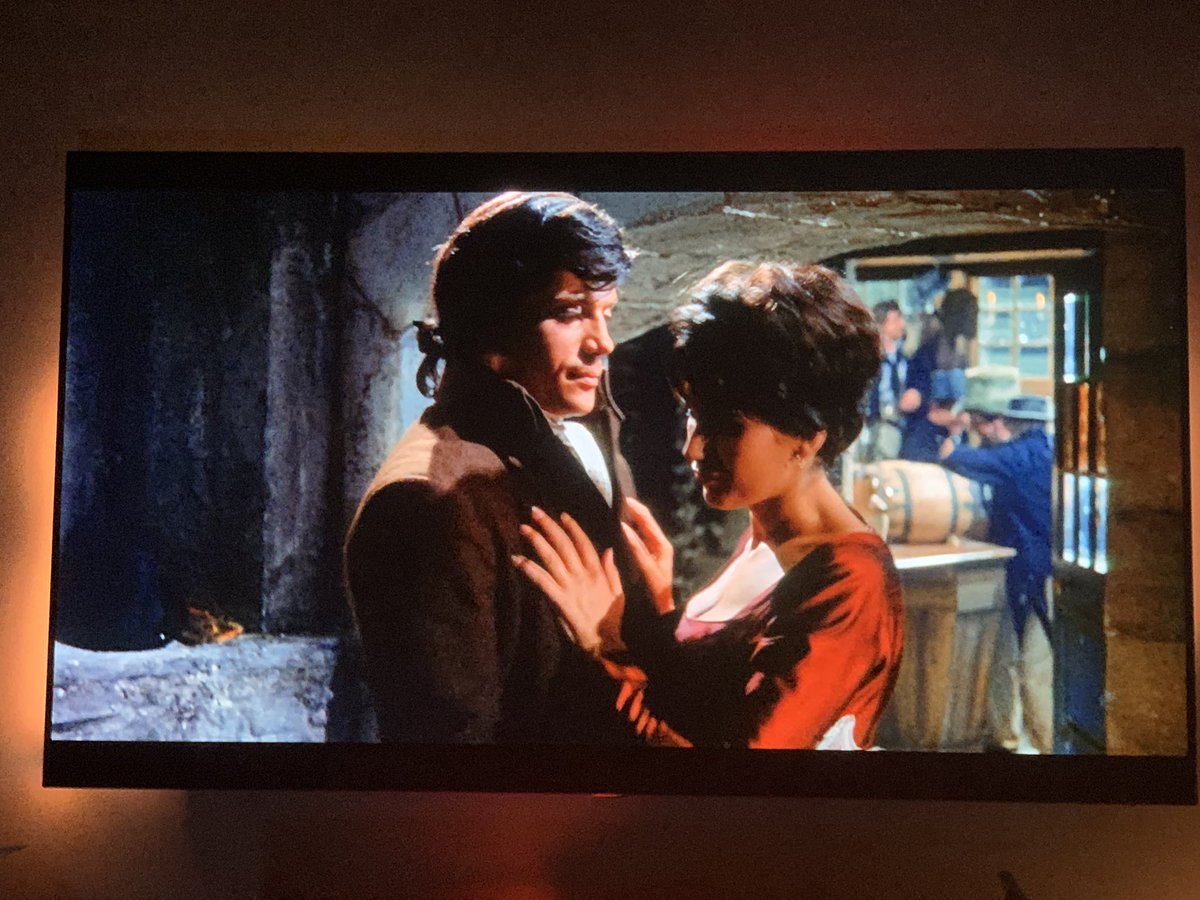



Leonard Maltin apparently stated that it had “some scary moments” which is a far greater mystery to rationalize than anything in Captain Clegg, as this scene is as terrifying as it gets.
Back to Vampires, Frankenstein, Mummies and Werewolves from here to Halloween.
Back to Vampires, Frankenstein, Mummies and Werewolves from here to Halloween.
The third Hammer Horror vampire movie, and the last before resurrecting Dracula, should cleanse the palate judging by this introduction:
Judged by a modern eye, Hammer’s Kiss of the Vampire lacks action & doesn’t seem to advance the genre beyond the 2 previous vampire films. But it unveils a core element that will become increasingly associated with Vampire movies:cults & the occult.
#31DaysOfHorror #HorrorMovies



#31DaysOfHorror #HorrorMovies




In also caters to one of the worst, primal human fear:being unable to protect loved ones-not just from death,but also from corruption & depravity represented by vampirism. A husband can’t protect his wife from abduction;a couple loses a daughter to a cult,as does a hero professor
Kiss of the Vampire also affirms the concept previously introduced by Hammer: that even a slight vampire bite is a deadly affliction that must be purged by fire/religious faith. Vampires are also able to withstand daylight if sufficiently overcast(ala Stoker’s Dracula novel) 

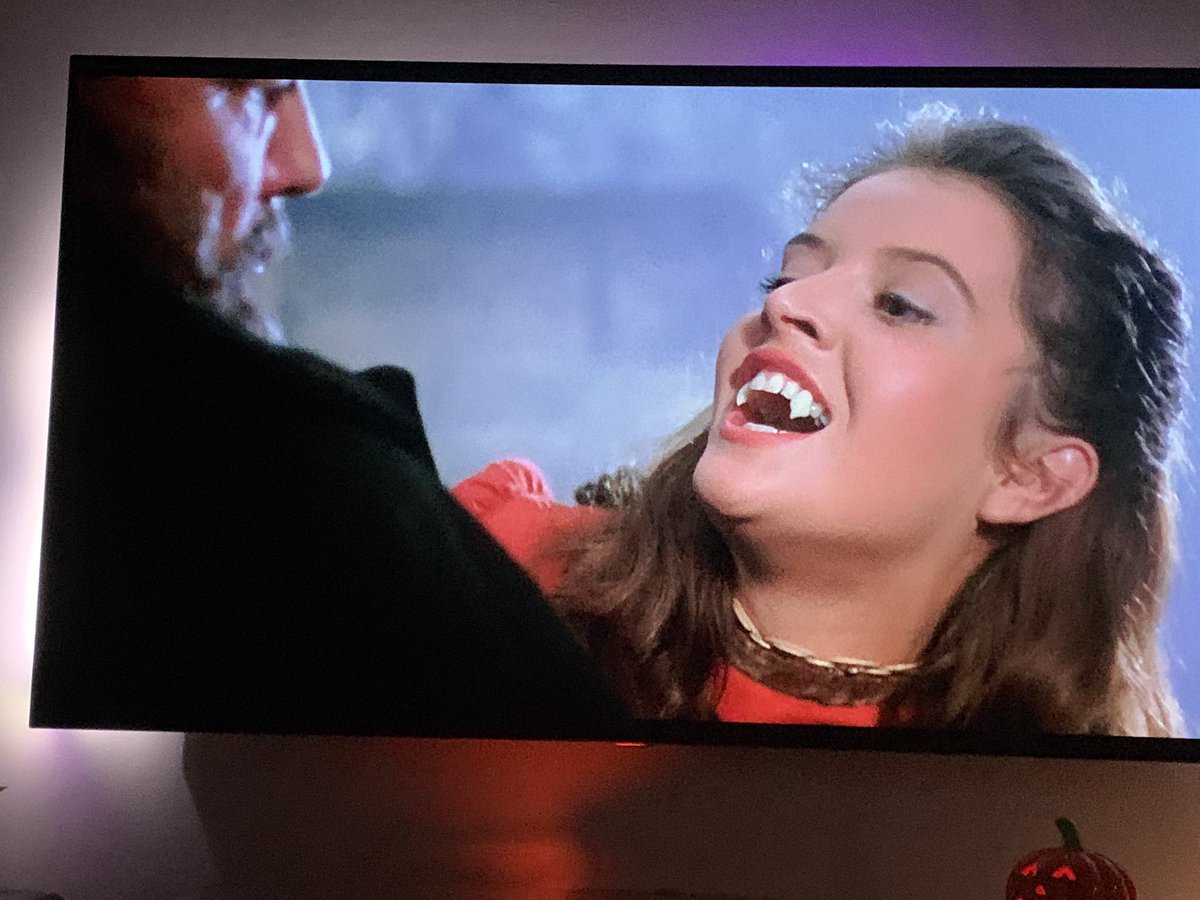

Vampires don’t turn into bats this time, but there are still plenty-o-bats in Hammer’s Kiss of the Vampire. Oh yes, my friends, there are bats. Bats in your whatnot.
Ultimately,vampirism is treated more like a degenerate disease than a mortal threat.Aside from seeking a recruit to their cult(which they go through extraordinary effort to obtain),these vampires are unthreatening, especially compared to the carnage caused by a drunken professor. 







The primal fear of being unable to protect your loved ones gives Kiss of the Vampire a nightmarish sense of building dread, and the occult/cult elements it seeds are reused more dramatically in later Dracula films.
Next in this Hammer marathon #31DayHorrorChallenge :
Next in this Hammer marathon #31DayHorrorChallenge :

The simplicity of Mummy films inherently limits the durability of their appeal-they’re all basically the same movie (other than Karloff’s 1932 Mummy & the 4th and final Hammer film): mummy awakens as lumbering, bandaged assassin to punish grave robbers. I’m fine with that hook.
The exotic nature of Egypt’s ancient past and the discovery of King Tut’s tomb and the resulting rumoured curse spawned the genre, and all the history/lore and imagery packed into Curse of the Mummy’s Tomb is still appealing. #31DaysOfHalloween #HorrorMovies 







The absence of Peter Cushing & Christopher Lee in Hammer’s 2nd Mummy movie is definitely felt, however. Instead we get this mysterious fellow (Terrence Morgan, in his sole Hammer Horror role) who enters a fray like a wannabe Bond. 





To add some confusion, George Pastell, who played the villain(Mehemet Bay) so effectively in Hammer’s 1st Mummy film, is back in the 2nd playing a character similar in name(Hashmi Bey) and background, but never stated to be related. He’s great again, even if he has less to do. 







As was the trend in Hammer movies of the era,the monster is absent during the initial 2/3 of the film & then relentlessly rampages to the finale.The stark violence of the Mummy is happily replicated in Curse of the Mummy’s Tomb,even if the bandaged lad has an unhealthy midsection
There’s just enough skull stomping, hand dismemberment, manhandling followed by more repeated skull bashing for the formula to work again, in The Curse of the Mummy’s Tomb. Truly an unnecessarily fat Mummy though.
Next:3 Frankenstein films in a row, starting with this soft reboot

Next:3 Frankenstein films in a row, starting with this soft reboot


Curse of Frankenstein & its sequel, Revenge of Frankenstein, are both wonderful: clever, feature the most interesting characterization of the Baron before or since, & offer genuine surprises to a staid tale. For Hammer’s 3rd Frankenstein film, that’s mostly gone in favor of this: 





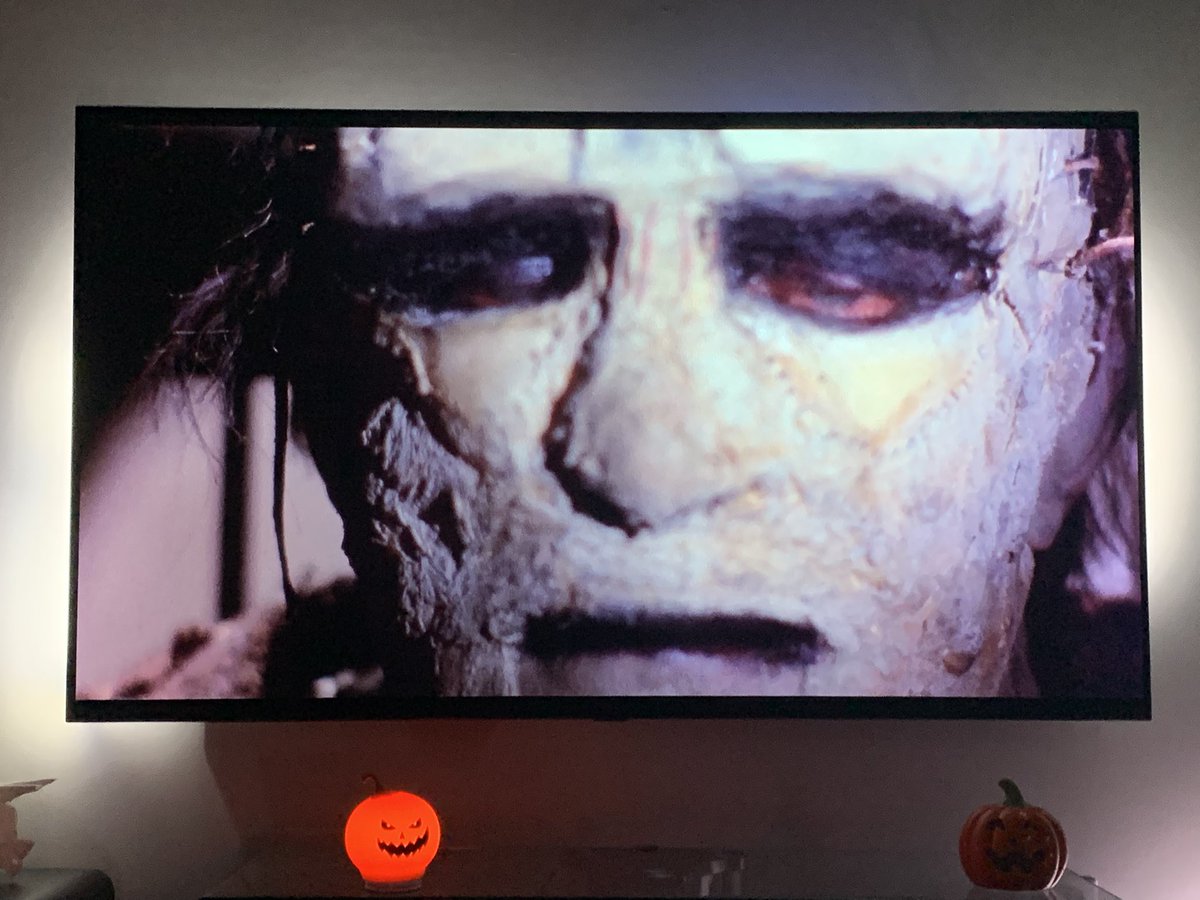

Revenge of Frankenstein picks up immediately after Curse, and follows Peter Cushing’s Frankenstein as he manages to perfect his creation-manufacturing a beautiful man instead of a monster-until undone by some bad luck. Frankenstein is brilliant, narcissistic, driven, sociopathic. 







Evil of Frankenstein has an opening segment that seems to maintain continuity, but then diverts to a full reboot that gives Frankenstein a revised backstory and personality more consistent with Universal’s earlier Frankenstein series (including lab equipment/use of electricity). 







Hammer gained the license to use Jack Pierce’s iconic monster look and rebooted to potentially appeal to US distributors.Although Chris Lee’s makeup in Curse was effective & distinct,Hammer tried to replicate Karloff’s flattop..and manufactured a farcically bad imitation-compare: 







I love Karloff’s Monster makeup-it still completely stands up 90 yrs later imo. As a kid, I wore out this book and its rudimentary paper mache monster makeup was arguable more effective than the utterly terrible “tape a cardboard box to noggin” Evil of Frankenstein atrocity. 







Evil of Frankenstein also is somewhat “broken”by HD clarity-aside from making the monster makeup even more laughable, it exposes the awful “ice”effects.
“Oh no, the monster is trapped in ice…or a shopping bag”
#31DaysOfHorror #HorrorMovies



“Oh no, the monster is trapped in ice…or a shopping bag”
#31DaysOfHorror #HorrorMovies




Most disappointedly, Cushing’s unique take on Frankenstein is gone. Aside from some residual arrogance, he’s no longer evil(despite the film title)but rather a persecuted man of science. Hans the assistant returns,but is also an altered, less sophisticated character. 







The monster is hypnotized into the only violence committed vs humans (effectively turning him into the same monster as the mummy), yet dangerously craves raw meat hinting at a darker creation lost in script-editing. #Frankenstein #31DaysOfHalloween
1964 was an interesting inflection point for Hammer Horror. Their film violence exceeded what was possible in Universal’s monster series, but by the late 60s gets tame by Hollywood standards.Yet they could still differentiate through cleavage and soon nudity, and leaned into that
Fortunately, Hammer seemed to realize that Evil of Frankenstein wasn’t the correct direction and course corrected for its next Frankenstein movie, which is more of a genuine sequel to Revenge. You can watch it tomorrow 9:30am EST on @tcm : Frankenstein Created Woman
Diverting to the 4th vampire movie by Hammer, in which Christopher Lee’s Dracula finally returns & he’ll remain a fixture until the end of Hammer’s initial run. It’s on @tcm later today, but I’ll be watching this fantastic Scream Factory CE, which has both US/UK versions 





Peter Cushing’s Van Helsing is sadly absent other than in flashback, but he’s ably replaced by this gregarious warrior priest, who is one of my favorite characters in all of Hammer’s Horror films. The chuckle at the end of his bark affirms.
#Dracula #31DaysOfHorror #HorrorMovies
#Dracula #31DaysOfHorror #HorrorMovies
It’s been 8 years since Horror of Dracula, and one of the best things about Prince of Darkness is it feels like Dracula’s return is well earned and not treated glibly, as in so many other sequels.
Dracula has no lines:Lee apparently stated that he refused to read them (unlikely, since he was working with same dir/writer team of Fisher/Sangster & had mute roles before); Sangster wrote that vampires don’t chat (yet he had talkative vamps in Brides & other vamps speak here). 







It seems most likely that Fisher/Sangster were just seeking to portray Dracula as the feral,enigmatic & powerful force of evil as we was depicted in Horror of Dracula after the introductory banter with Harker. It definitely makes Dracula intimidating and frightening/otherworldly.
Hammer also builds on its established vampire lore in Dracula, Prince of Darkness: even slight bites still need to be cauterized;Dracula hypnotizes; vamps have dangerous human helpers; even makeshift crosses are highly effective (as in Brides) & drinking Draculas’s blood corrupts 




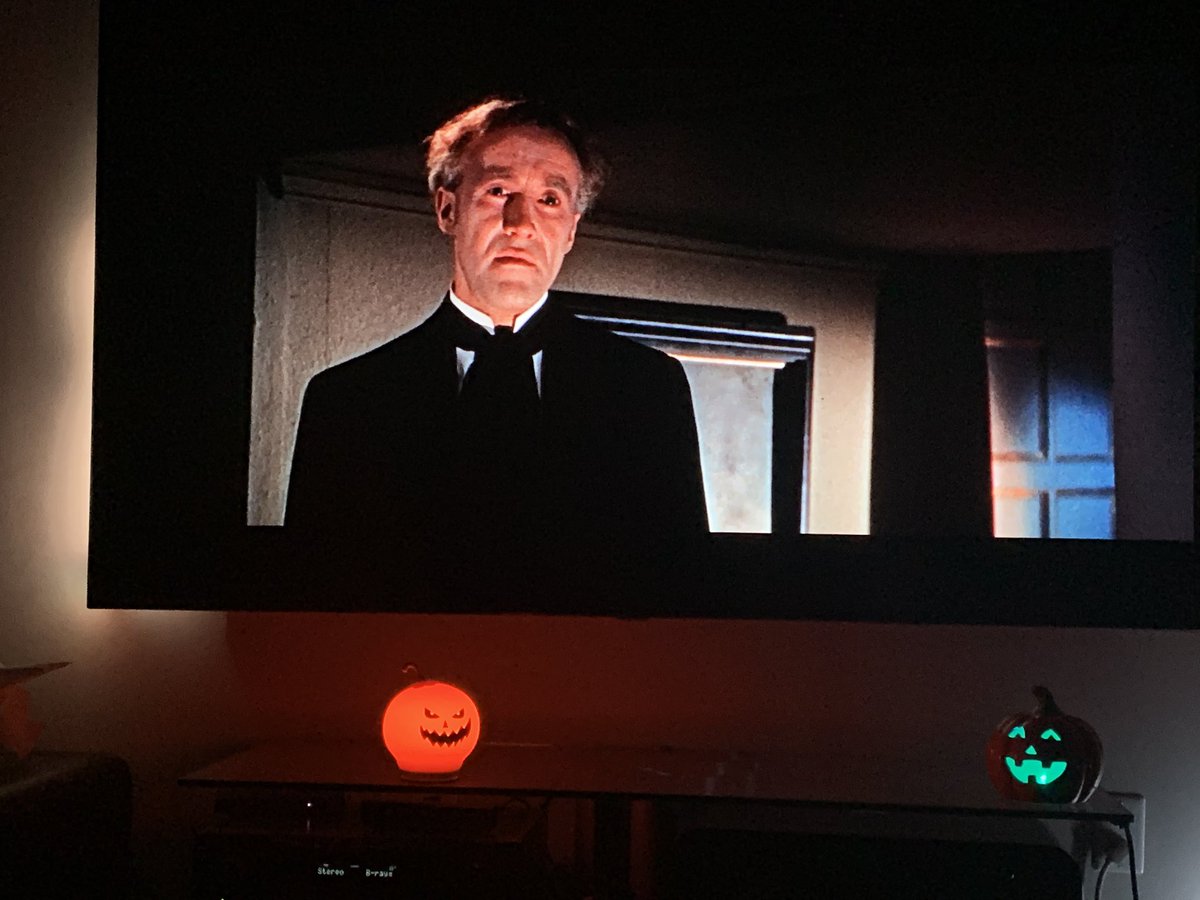
In its 4th vampire film (3rd in Dracula series),Hammer is still culling Stoker’s Dracula novel for content-introducing a weak-willed, fly chomping madman playing the same role as Renfield in the Dracula novel. But also sourcing vampire lore by adding a weakness to running water. 







This scene gave me legit nightmares as a kid, as an attempt to slay Dracula in his coffin is attempted too close to sundown and the hunter becomes the hunted. “it’s too late!” #DraculaPrinceOfDarkness #31DaysOfHorror #31DaysOfHalloween
#31DayHorrorChallenge
#31DayHorrorChallenge
This film is a Gothic Horror classic and very representative of how effectively Hammer could establish an atmosphere of dread and build tension until it explodes in horror. While simpler than its predecessors, it’s aged better and its formula is timeless. #DraculaPrinceOfDarkness
Jumping forward to 1968 and Hammer’s 4th movie in the Dracula series:Dracula has Risen From the Grave. Hammer was really cooking in this period and there were a bunch of one off movies I’ll cover eventually but not now: Devil Rides Out; The Gorgon; The Reptile; Plague of Zombies. 







The route & exterior to Dracula’s castle vary in all 3 films they’ve been featured but the series still retains general continuity. But vamp lore & rules established by Hammer’s prior films are broken in this egregious scene & even worse later in a scene you def won’t miss.
This time Dracula appears far earlier than the Hammer mold dictated in prior horror films, yet his return is still earned. One feature from Stoker’s novel that’s happily a fixture of Hammer’s series is Dracula’s persistent targeting of loved ones of enemies-he’s a homing missile
While Dracula still isn’t exactly loquacious, which seems a waste of Christopher Lee’s resonating voice; this interpretation of Dracula is still easily my favorite. He has such magnetism, exudes evil and is so intimidating & savage beneath his charismatic exterior #Dracula 







While the character of Dracula has always been a dark,seductive and corrupting figure,until Hsmmer’s Dracula Has Risen From the Grave, allusions to the sexual nature of the character have never been overtly depicted.This is truly a ground-breaking moment. #dracula #31DaysOfHorror
I love Terence Fisher’s films,but Dracula Has Risen From the Grave is the sole movie in Hammer’s series directed by Freddie Francis & it has superlative imagery(cinematographer Arthur Grant was a Hammer regular who worked on many films in this thread).Dracula never looked better. 






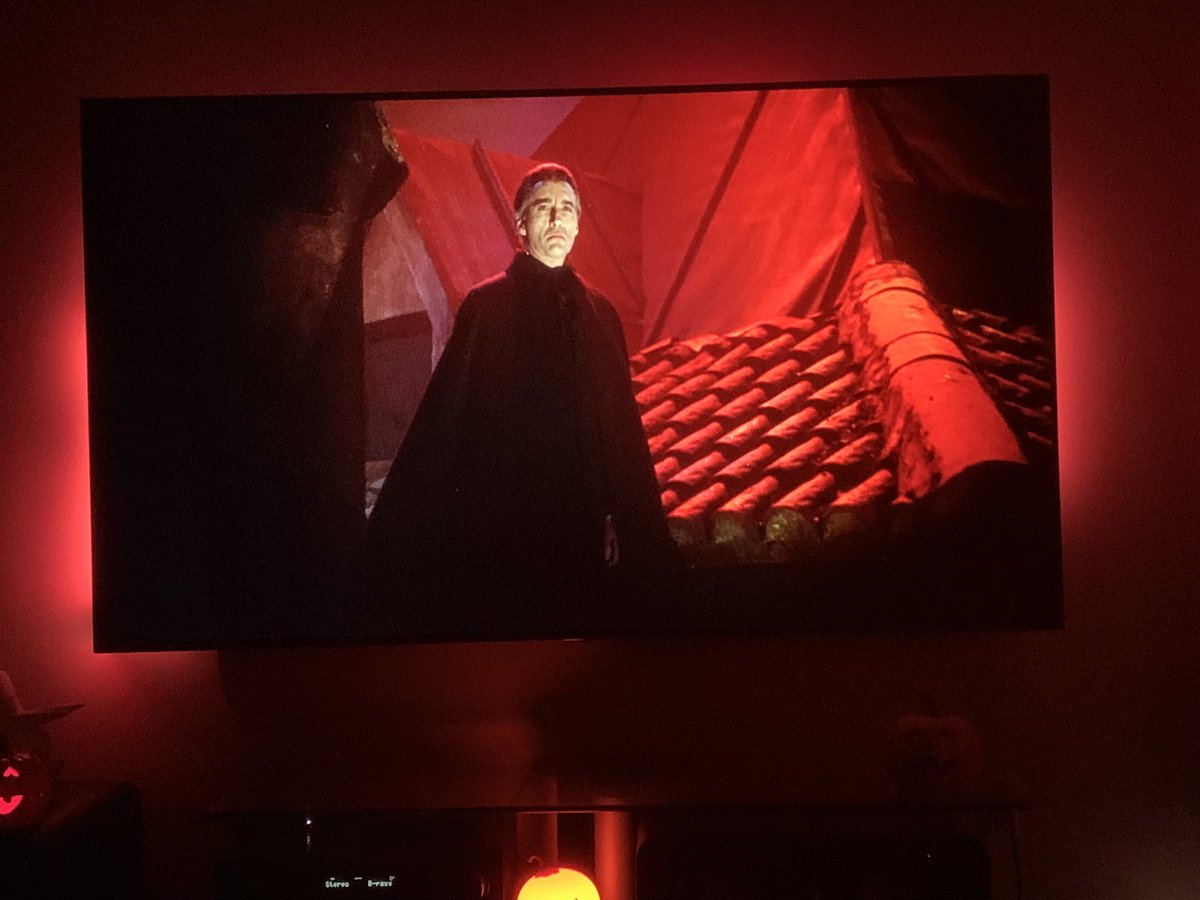
Frankenstein Created Woman is the 4th movie in Hammer’s series & a return to form. It’s very similar to Revenge of Frankenstein in that it has a smart script that logically advances the experiments of Cushing’s amoral but charismatic Frankenstein, but lacks a traditional monster. 







The lack of a monstrous creation somewhat diminishes the energy of these instalments,but Cushing is so magnetic that I love them. His overt arrogance is elevated,often to humorous effect-His experiments become more fascinating as they are increasingly metaphysical & contemplative 







No explanation is given for how he escaped his fate in the previous film, although he has damaged hands which limit his ability to operate directly. He’s still a force of nature, steamrolling through obstacles in pursuit of cheating death through capturing souls. #hammerhorror
Frankenstein’s role is somewhat reduced-there are far more scenes where he is absent compared to the other films in the series-the remaining characters are well formed and performed,but more Frankenstein is always preferred.The feeble defensive efforts of victims is quite amusing
Bad sequels just remake the original, often in exaggerated form, but quality sequels logically world build and explore new territory and further develop characters. Frankenstein Created Woman uses the foundation of the first 2 films to explore big ideas like these:
Next up: one of the best of Hammer’s Frankenstein series, Frankenstein Must Be Destroyed, in which Peter Cushing’s Baron Frankenstein finally becomes utterly unredeemable and earns a dirt nap.
#FRANKENSTEIN #HorrorMovies #31DaysOfHorror

#FRANKENSTEIN #HorrorMovies #31DaysOfHorror


In previous instalments of Hammer’s Frankenstein series, the Baron has been depicted as an amoral murderer-driven to advance scientific knowledge at any cost-but also vain & self-interested (other than in Evil of F, where he’s almost heroic ala Colin Clive). Also, sardonic:
But in prior films his aim was to advance science & his crimes were to prevent his pursuit of that knowledge from being constrained. In Curse of Frankenstein he details horrific acts to stave execution,as if he believes it’s obvious he was justified because of his scientific goal
Arguably that made him an anti-hero:willing to commit distasteful/evil acts, but for a beneficial scientific goal. That nuance is finally removed in Frankenstein Must Be Destroyed,as the Baron goes full narcissist & ruthlessly murders, blackmails and, most controversially, rapes. 





That latter crime is rumoured to have been added late in production to appeal to US distributors.Not sure I believe that,as it serves a much clearer,more thematically consistent purpose:it makes Frankenstein unredeemable and unquestionably a villain more than any other act could. 





The main problem I have with the film is instead how easily Frankenstein gets an innocent couple to repeatedly commit horrid crimes to avoid being blackmailed for drug use. If you’re willing to murder to avoid jail; why in Hades wouldn’t you just chop up old Frankenstein instead? 





The one character who does stand up to the Baron is ironically the only one who arguably benefits from his crimes, but Frankenstein’s creations rising against him is a consistent trope. This film does seem to complete his arc so it’s not surprising that its sequel is a reboot.
Next: Hammer’s 5th Dracula series film, in which characters are given the amazing choice to:
-taste the blood of Dracula and die; or
-refuse to taste the blood of Dracula and die.
Drac’s back, baby. Drac’s back.
#Dracula #Favorite_Vampire
-taste the blood of Dracula and die; or
-refuse to taste the blood of Dracula and die.
Drac’s back, baby. Drac’s back.
#Dracula #Favorite_Vampire
Taste the Blood of Dracula gets off to a great start: an unlikeable chap finds himself in an unexpectedly threatening situation and stumbles precariously into the final scene of the previous movie, Dracula has Risen From the Grave. Love the continuity.
Ralph Bates makes his 1st Hammer appearance and is a fantastic creep. He gets a trio of hedonistic jerks to spend a fortune to join in on the worst concoction imbibing party ever. Bottoms up!
It says a lot when the greedy salesman-who is so unlikeable that it’s amusing when he gets thrown out of a carriage onto his noggin-is practically amiable compared the rich jerk trio and the Satanic Prince played by Bates. 







The film is stock full of unlikeable characters so that it can then happily brutalize them. Taste the Blood of Dracula is delightfully cruel, as one victim after another is butchered by a smiling loved one under Dracula’s hypnotic spell.
That’s also a downside:Dracula is relegated to being a glaring puppet master,when he’s actually most terrifying as both a powerful actor in addition to schemer. He’s too passive here,and the finale is sudden and silly. It has one great murder scene, but otherwise is a weak sequel 







Upcoming: more fresh Hammer blu-rays, including the Dracula film often mentioned as the weakest (all rest will be covered), and the strange attempt to reboot Frankenstein again 

While Scars of Dracula maintains a modicum of continuity, gone are the days when rebirthing Dracula required a complex scheme and 45 minutes of machinations to rationalize.
All that’s now needed is some bloody bat spittle and Drac is good to go, 2 min into the film. #Dracula
All that’s now needed is some bloody bat spittle and Drac is good to go, 2 min into the film. #Dracula
I’m fine with the more rapid, less involved explanation for Dracula’s return-after all, this is the 6th movie in the series and insufficient use of the character has hampered some films. For only the 2nd time (the other being Brides of Dracula), vampires can turn into bats.
Hammer, to this point (7 vampire movies in), has been consistent with its vampire lore aside from a couple tweaks and Van Helsing stated in Brides that only some vampires could turn into bats. The bat effects were poor in that film and 10 yrs later they are, well..
Hammer films were doing less well commercially & their leisurely pace,low body counts & limited FX weren’t meeting audience desires. So Scars has a much faster pace & increased carnage & sexiness (greatly increased in Vampire Lovers,released same yr),but FX still Dr Who-level bad 

Enjoy his films retaining continuity by showing how Dracula was revived from his previous demise, but doing so & then killing him again by film’s end meant he’d only been revived each time for a few hours. His “great reign”of terror has amounted to about 6 hours total in decades.
Dracula (and his bat brethren, who are controlled animals rather than full vampires) are very active in Scars of Dracula. Chris Lee has more dialogue than in all his previous Drac films combined. He’s vicious and sinister; but also a charming host as in Stoker’s novel.
Scars of Dracula seems to be largely maligned for its gore (a plus, imo) & small budget & resulting cheesy effects/limited sets. But I loved seeing elements from the novel such as the Count wall-climbing, hosting guests & using animals. His inaccessible lair is an inspired touch. 







While its story is under ambitious, Scars of Dracula succeeds in making the Count smart, sadistic & dangerous again. Attack him, try to find his coffin or challenge his will and he’ll gleefully enjoy inflicting a high price on your actions. Much more interesting than I expected. 







The Scream Factory Blu-ray for Scars of Dracula deserves lauding: the film looks great, and the original 1.66:1 aspect ratio version is provided in addition to a 1.85:1 version, and two audio commentaries, including one by Christopher Lee & director Roy Ward Baker. 





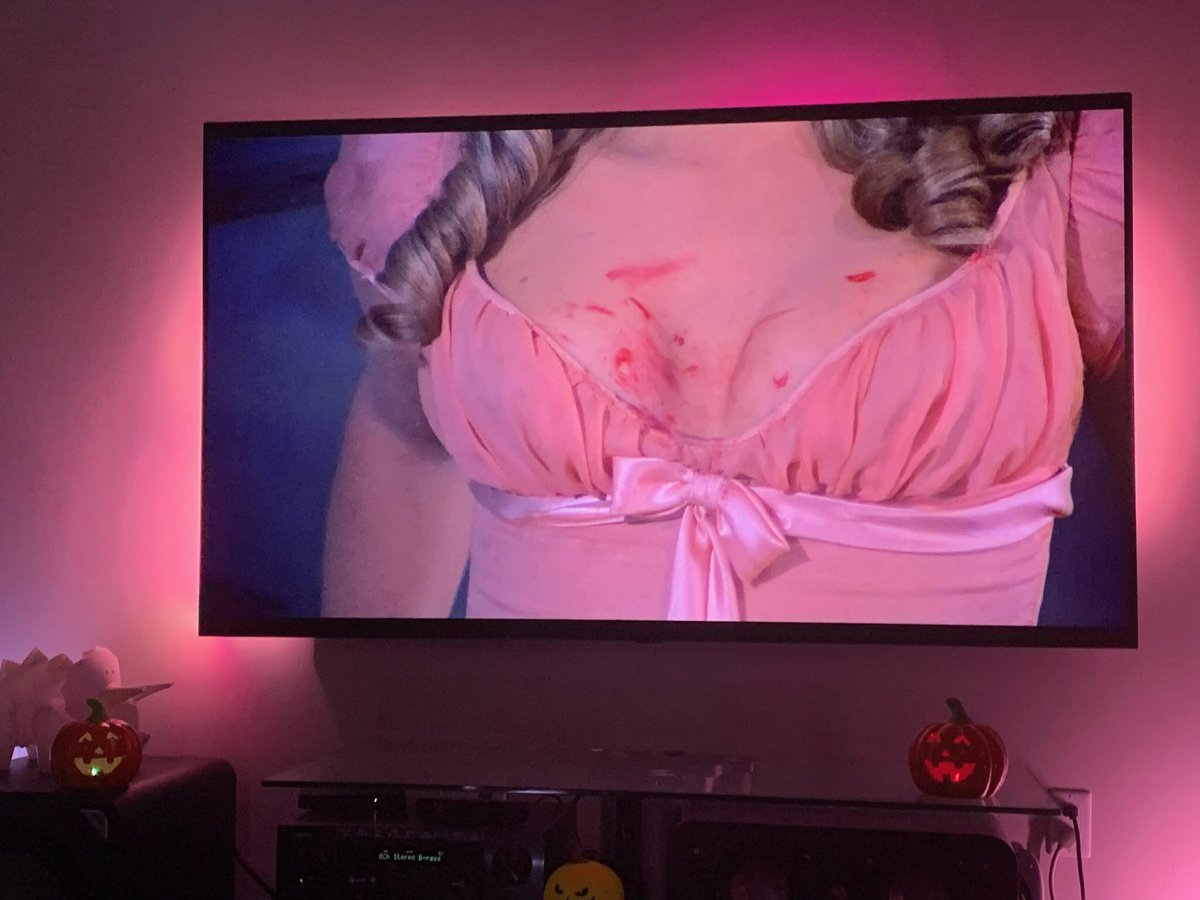
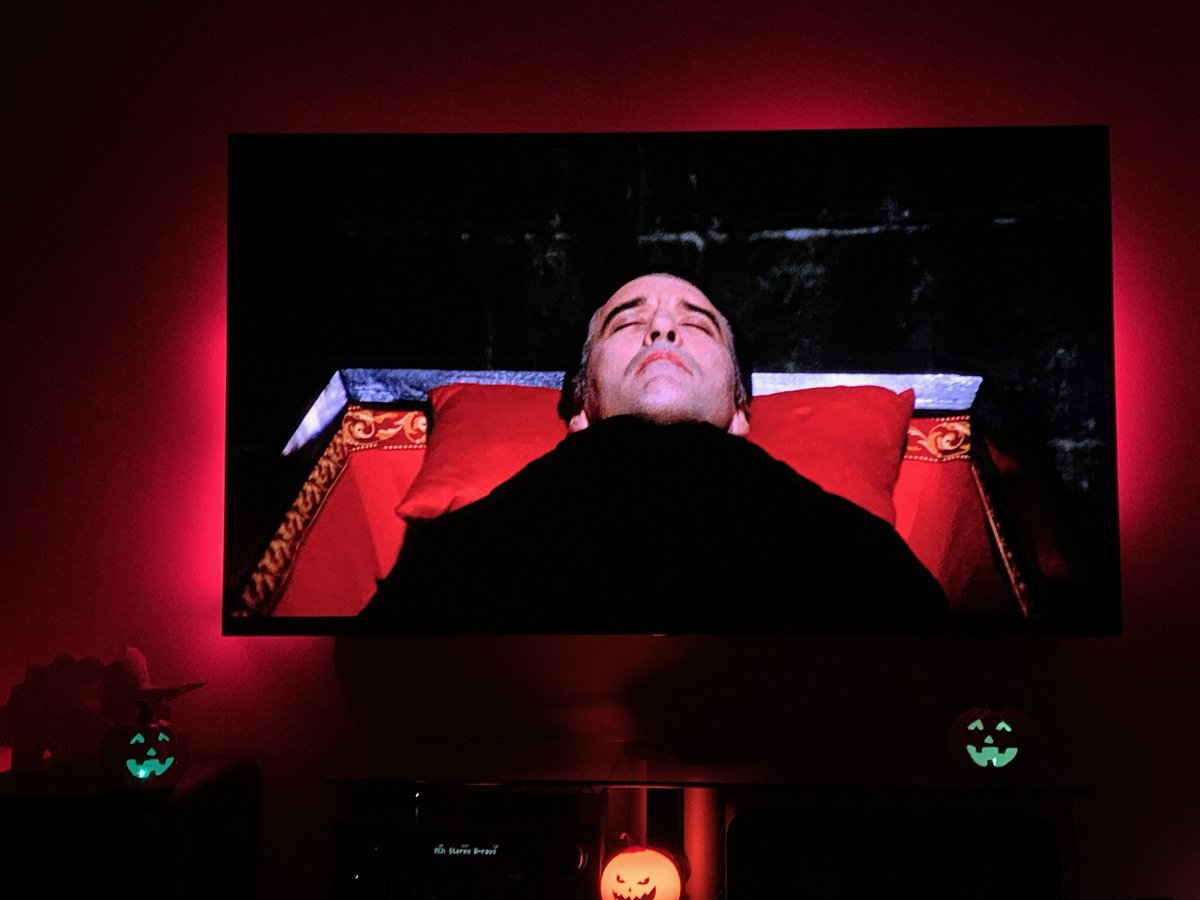
Hammer finally decided to soft reboot its Dracula series by moving the Count from his Gothic castle to contemporary London in Dracula AD 1972, and disregarded prior continuity seemingly solely to have Drac dead for exactly 100 yrs. #dracula #31DaysOfHorror
It wasn’t a terrible idea, given Hammer’s struggle to remain relevant/non-campy to modern audiences. The Night Stalker (discussed in a separate thread)also brought a traditional vampire to a modern setting-unfortunately for Hammer, Dracula AD 1972 compares poorly to Night Stalker
While in The Night Stalker the ancient vampire has adapted to the setting & utilizes modern tools(blood banks,cars,disguises) & actively hunts and is capable of outwitting & fighting authorities in several confrontation-in AD 1972,Dracula just waits in a church until found & KOed 







The attempt to modernize the series ironically may now make it a better period piece than the older films (Night Stalker is also a great window into mob-era 70s Vegas). 1970s London is a fantastic place to visit:the music;clothes;bars;the hippies. Yes, dirty rotten hippies. 





Dracula AD 1972 has an identical setup to Taste the Blood of Dracula:selfish fools, bored with their usual carnage, decide to liven things up with an occult ceremony that revives Dracula. While we’re presumably supposed to be more sympathetic to this crew, they’re a wretched lot. 







Peter Cushing is back, fighting Christopher Lee’s Dracula for the 1st time since the original 1958 film. Like Lee here, he doesn’t get a lot to do, but Cushing adds a lot-He never mails in a performance. Relentlessly earnest, even when inadvertently getting a handful of boob:
Lee also brings gravity to a very passive role. Unusually, Dracula also converts a male victim to vampirism, who in turn does the same. It’s novel to have additional male vampires in a Hammer Dracula film-Christopher Neame is suitably creepy but sidelining Lee always is a mistake
Dracula AD 1972 considered alone is a weak sequel, but it’s essentially part 1 of a 2 part story that’ll be concluded by The Satanic Rites of Dracula, which is FAR wilder and does more to integrate Drac into the setting. I still enjoyed the jaunt to 70s London-but it’s no Blow-Up 







Some health woes and since it’s now November 3rd, it’d be reasonable to assume my Hammer Hammer Marathon is over.
Not for an instant. Devil Rides Out is next.
Not for an instant. Devil Rides Out is next.
The Devil Rides out allows Christopher Lee to give one of his finest, most charismatic performances. And unlike the plethora of other devil worship movies released in the late 60s, this film doesn’t short-change viewers on black magic displays. Take a gander at the devil himself:
That said, it’s Hammer Horror, so don’t exactly expect the Exorcist level effects. There’s a lot of hokum, but it’s largely obfuscated by a script that implies deeper lore and Lee’s character constantly drops tidbits that add gravity.
Lee’s voice capably sells twaddle.



Lee’s voice capably sells twaddle.




The pomp & spectacle contains the right mix of respectability & intrigue, spiced with subtle magical displays & suggestive horror. Richard Matheson’s script creates significant but personal stakes, with dialogue that’s a pleasure to watch as Lee & Charles Gray gentlemanly spar. 







Given the extreme vulnerability of Hammer vampires to even makeshift crosses, the trend to conflate Dracula with the devil worship film craze worked well for Hammer’s later films (it was teased into Marvel’s Tomb of Dracula comic then too). Never more than in Lee’s finale, next: 

• • •
Missing some Tweet in this thread? You can try to
force a refresh







